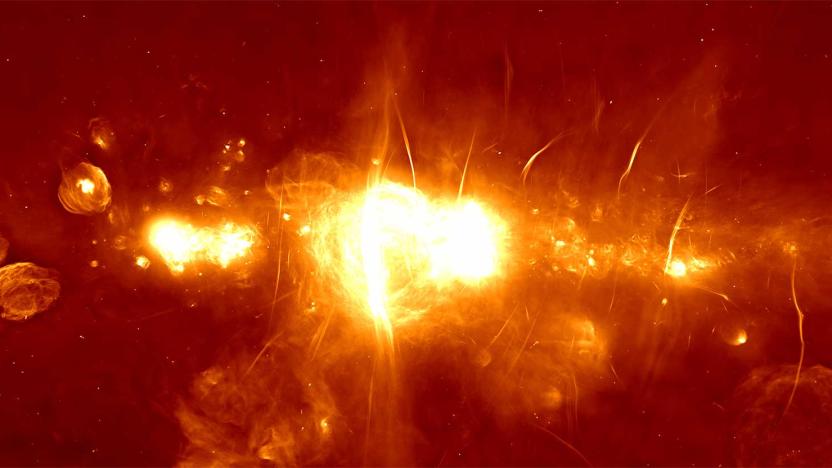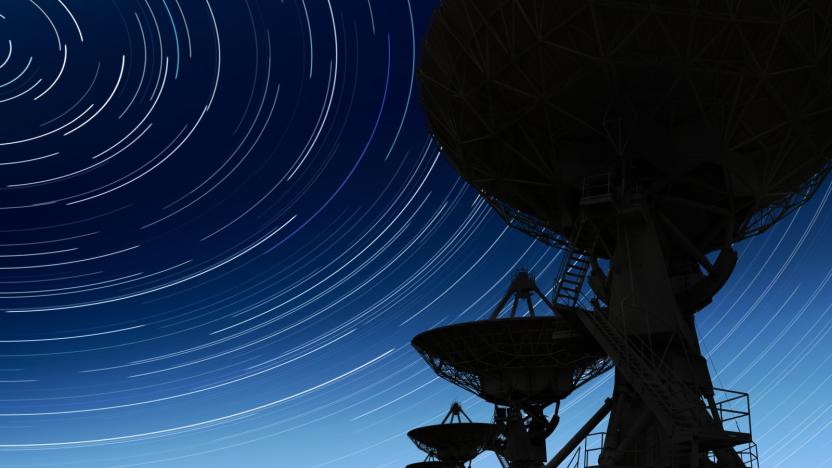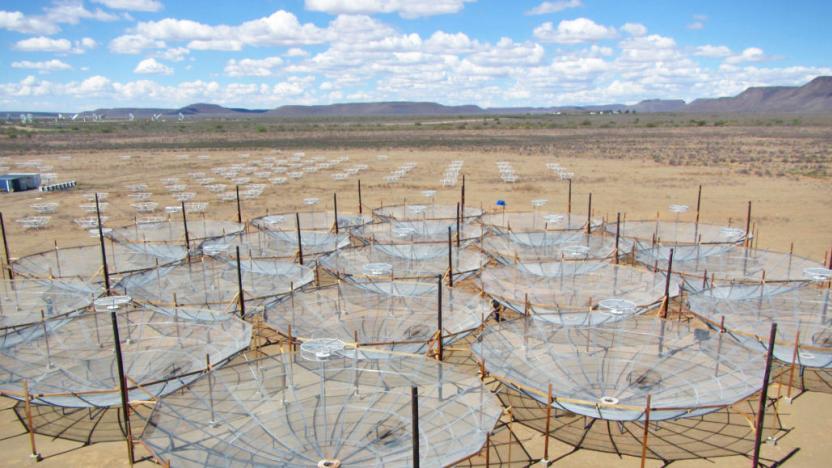squarekilometerarray
Latest

Ultra-sensitive radio telescope debuts in South Africa
Another piece of the Square Kilometer Array's puzzle just fell into place. South Africa has officially switched on MeerKAT, billed as the most sensitive radio telescope of its type on the planet. Some parts of the array have been gathering data, but it's now nearly ready to use interferometry from all 64 dishes to map the normally invisible portions of space in exceptionally high detail. It should be completely ready for scientific experiments in about two months, according to Nature. However, you won't have to wait that long to see fresh results -- you're looking at some above.

Listening to starlight: Our ongoing search for alien intelligence
Six hours a day, seven days a week, for four straight months. That's how long radio astronomer Frank D. Drake pointed the 26-meter telescope at the National Radio Astronomy Observatory (NRAO) research facility in Green Bank, West Virginia, toward the heavens, looking for signs of intelligent life beyond Earth. He dubbed his efforts Project Ozma, in honor of the Queen of Oz from L. Frank Baum's famed children's book series.

HERA telescope upgrades could reveal the earliest stars
When it first went online in February 2016, the Hydrogen Epoch of Reionization Array (HERA) radio telescope in South Africa boasted 19, 42-foot-diameter antennas aimed at the "Cosmic Dawn" of the universe. The antennas are designed to detect a specific wavelength of light emitted by hydrogen atoms during what's called the "Epoch of Reionization," which scientists believe started about 400 million years after the Big Bang. By picking up these wavelengths of light, HERA will be able to form a clearer picture of the universe at a time when the first stars and galaxies were being formed, more than 13.7 billion years ago.

Murchison Widefield Array goes live, will study the sun, space junk, the early universe and more
We hope IBM's hardware is ready to chew through the feast of data it's going to receive, as the Murchison Widefield Array (MWA) radio telescope is officially open for business science. Located in the outback on the same site as the Australia SKA Pathfinder, it's one of three "precursor" programs that'll help steer future development of the extra powerful Square Kilometer Array. The MWA low-frequency telescope has plenty of work to be getting on with, and some of its first tasks include gazing into the sun to observe solar flares, storms and other activity, as well as scanning the Milky Way for the likes of "black holes and exploding stars." It'll also look into the tracking of hazardous space garbage using FM radio waves that are lost to the void, and explore the early life of the universe as far back as 13 billion years. According to Curtin University's Professor Tingay, the MWA's commendable work ethic (read: data quality) means we could see initial results from some of these projects "in as little as three months' time."

Australia Square Kilometre Array Pathfinder goes live as the world's quickest radio telescope
Australia's Shire of Murchison is quickly becoming a hotbed for radio telescopes. As of of Friday, the territory is operating the world's fastest radio telescope in the form of the Australia Square Kilometre Array Pathfinder (ASKAP). The 36-antenna grid's eventual use of six phased array feeds, each with 188 receivers, will let it scan a field of view 150 times larger than the moon's visible area while processing that information much faster than a typical single-pixel radio telescope feed -- CSIRO estimates that an image of the Centaurus A galaxy that would take 10,000 hours to process with rivals should take five minutes with ASKAP. Ultimately, the array should grow to 60 antennas as part of the Square Kilometer Array, which includes South Africa in its hunt for pulsars, quasars and other unique parts of the universe. Just don't get your hopes up for booking alien listening sessions anytime soon. Commissioning started virtually as soon as the ribbon was cut, and scientists have already scheduled their usage slots for the next five years. We're sure we'll get over any frustration when we see the first ASKAP results published within the next year.

IBM: 'We must build an Exascale computer before 2024' (video)
ASTRON has enlisted the help of IBM to lead a five-year, $43 million project to develop and build a supercomputer for the new Square Kilometer Array. The SKA is a $2.1 billion initiative to construct the world's largest radio telescope across a 3,000km strip of Australia or South Africa. It's hoped to be around 50 times as powerful as the dishes we currently point heavenward and will be used to examine the deepest reaches of space to learn more about the formation of the universe. When it goes live in 2024, it'll produce an Exabyte of data each day: twice as much information as there is traffic on the internet in the same period. Of course, no existing computer could handle the job, so Big Blue has a slim 12 years in which to turn nascent technologies like Nanophotonics, 3D chip stacking and phase change memory amongst others into a practical, workable Exascale computer. Its either that, or somehow daisy-chain 100 million PCs with enough power and cooling fans to keep it all working and hope for the best. If you'd like to know more, then head on past the break, although unfortunately it won't count as college credit.

SKA radio telescope to pump out more data than the internet in 2020, spot ALF before he lands
Unfortunately for Desmond Dekker fans, this SKA telescope has nothing to do with the Jamaican music sensation. No, the Square Kilometer Array (SKA) radio telescope has much more otherworldly concerns, and according to the director of the International Centre for Radio Astronomy Research (ICRAR), Peter Quinn, it should have the internet beat in terms of data when it goes online in 2020. The telescope, which will end up in either Australia, New Zealand, or South Africa, is aimed at searching for Earth-like planets, extraterrestrial life, dark matter, and black holes, and will require a central supercomputer with "the processing power of one billion PCs." What's more, it is expected to be 10,000 times more powerful than any telescope in existence and "generate the same amount of data in a day as the entire planet does in a year." We say anything that gets us closer to having our very own hairy, Hawaiian-shirt sporting alien on hand is well worth the $2.1 billion it will cost to create. Willy!




